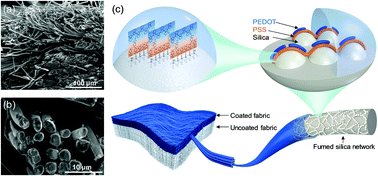All-organic flexible fabric antenna for wearable electronics†
Abstract
Next-generation wearable systems call for flexible, breathable, and skin-friendly wireless transmitters for realizing body area networks and the internet of things. This work presents the first fully functional, poly(3,4-ethylenedioxythiophene):polystyrene sulfonate (PEDOT:PSS) screen-printed fabric patch antenna for next-generation wearable antennas. This is an unparalleled milestone as prior conductive polymer based fabrics all demonstrated insufficient RF radiation due to skin effect loss, whereas here, an all-organic fabric RF transmitter is realized with the help of nanotemplate-assisted PEDOT:PSS conductive phase segregation on the surface of fabric fibers, forming a continuum coaxial structure with a conductive shell. This multi-strand wire structure endows the conductive fibers with a high surface area that is similar to high frequency Litz-wire, resulting in an extremely high RF conductivity. The fabricated patch antenna based on this conductive fabric shows an extremely low return loss of −50 dB and a satisfactory radiation efficiency of 28% at its resonant frequency of 2.35 GHz, and preserves its performance characteristics when bent over a representative phantom. In addition, the Doppler radar system based on the fabric patch antennas demonstrates satisfactory speed and distance detection with high precision, well suited for future application as a short-range sensing device for blind assistance. This development paves a new way to fabricate all-organic flexible RF devices for wireless communication with profound implications for the field of integrated wearable electronic networks.

- This article is part of the themed collection: Journal of Materials Chemistry C HOT Papers


 Please wait while we load your content...
Please wait while we load your content...